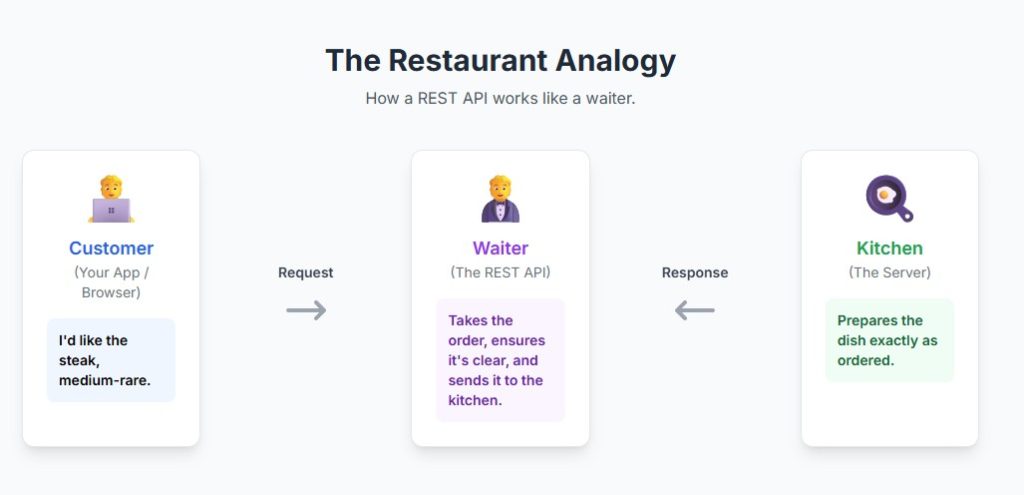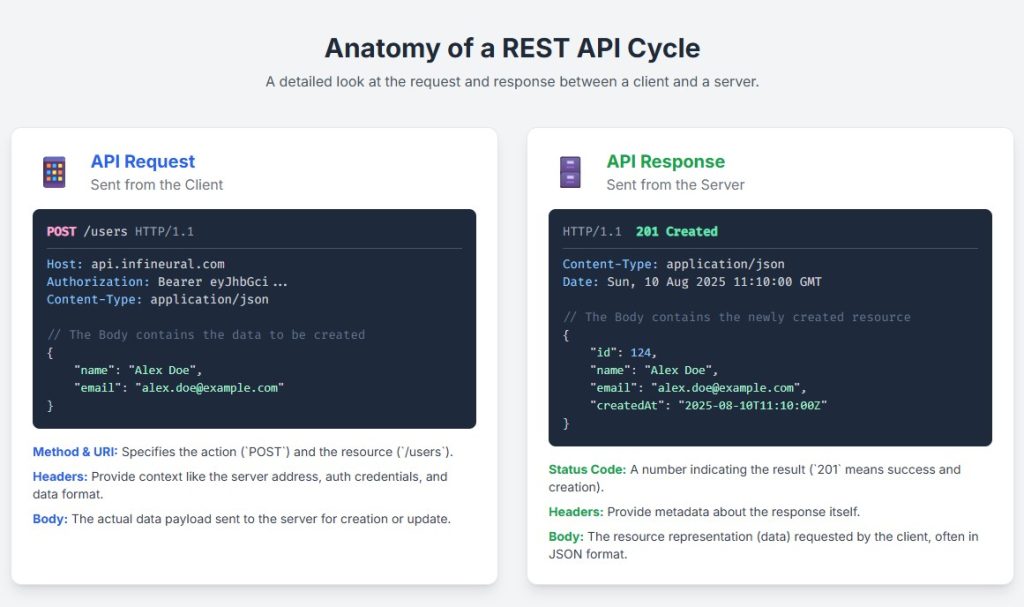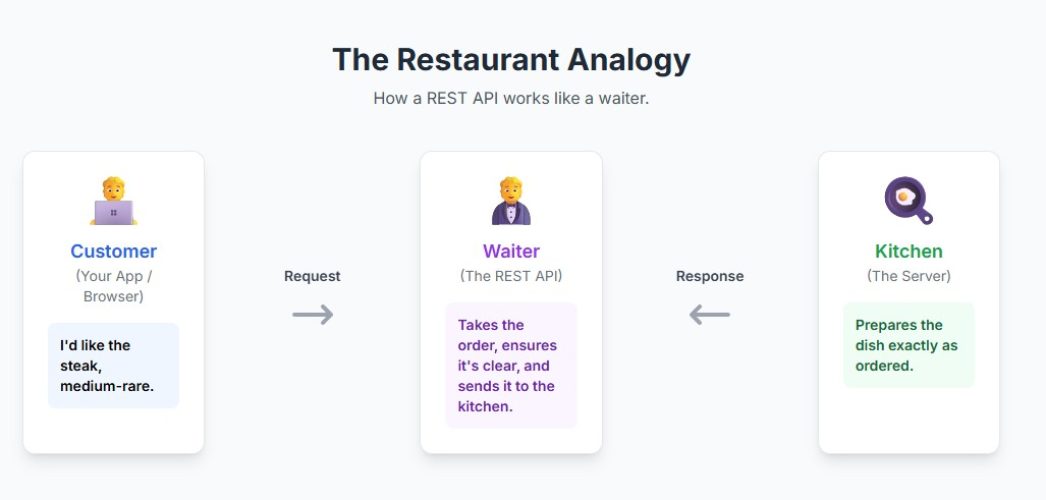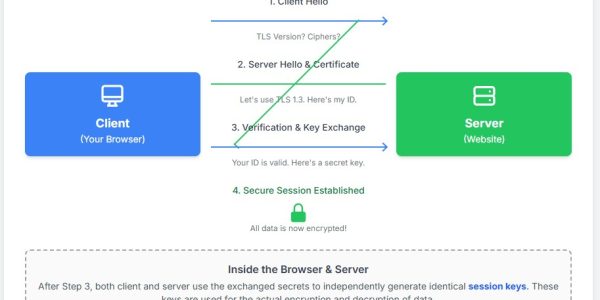Imagine you’re at a bustling restaurant. You, the customer, want to order a specific dish. The kitchen, full of expert chefs, has all the ingredients and skills to prepare it. But how do you get your request to the kitchen and the food back to your table? You need a waiter. The waiter acts as an intermediary, taking your order (the request), communicating it to the kitchen (the server) in a way they understand, and bringing your dish (the response) back to you.
In the digital world, a REST API works a lot like that waiter.
This simple analogy is the key to understanding one of the most fundamental technologies powering the internet today. If you’ve ever wondered how your weather app gets live data, how you can log into a service using your Google account, or how different software applications seamlessly talk to each other, you’re in the right place.
By the end of this guide, you will not only understand what a REST API is, but you’ll also grasp its core principles, its benefits, and how it acts as the invisible backbone of modern web development.

What is an API, Anyway?
Before we dive into REST, let’s quickly define its parent term: API, which stands for Application Programming Interface.
An API is a set of rules, definitions, and protocols that allows different software applications to communicate with each other. It’s not a database or a server; it’s the messenger that runs back and forth between applications, delivering requests and responses. It defines the “language” and “contract” that software programs can use to request and exchange information.
Think of it like a power outlet. You don’t need to know how the power grid works. You just need to know that your plug fits the outlet’s standard interface to get the electricity you need. An API provides that standard interface for software.
So, What is a REST API Specifically?
Now for the main event. REST stands for REpresentational State Transfer. It’s not a protocol or a standard, but an architectural style for designing networked applications. A REST API (also known as a RESTful API) is simply an API that adheres to the constraints of the REST architectural style.
Developed by Roy Fielding in his 2000 doctoral dissertation, REST was created to provide a set of principles for building scalable, flexible, and easy-to-use web services. It leverages the existing technology and protocols of the World Wide Web, most notably the Hypertext Transfer Protocol (HTTP).
In simple terms, a REST API breaks down a transaction to create a series of small modules. Each module addresses a specific part of the transaction. This modularity makes it a flexible and developer-friendly approach to building APIs.
The Six Guiding Principles (Constraints) of REST
For an API to be truly “RESTful,” it must follow six specific architectural constraints. Understanding these is key to understanding what a REST API is at its core.
- Client-Server Architecture: The system should be separated into clients (the ones making requests, like your browser) and servers (the ones holding the data and fulfilling requests). This separation of concerns means the client and server can evolve independently, as long as the interface between them remains unchanged. This improves portability and scalability.
- Statelessness: This is a crucial one. Stateless means that every request from a client to a server must contain all the information the server needs to understand and fulfill the request. The server does not store any information about the client’s state between requests. Each request is treated as a brand new, isolated interaction. This makes the system more reliable, as the server doesn’t need to remember past interactions, and it simplifies server design.
- Cacheability: To improve performance and reduce server load, responses from the server should be defined as either cacheable or non-cacheable. If a response is cacheable, the client can reuse that data for a certain period without having to make the same request again. This is why when you check the weather, the app might show you the last fetched data before requesting a new update.
- Uniform Interface: This is the fundamental principle of REST design, ensuring a consistent and predictable way of interacting with the API. It simplifies the architecture and makes the system easier to understand. It is composed of four sub-constraints:
- Resource Identification: Each resource (e.g., a user, a product, an article) is uniquely identified by a URI (Uniform Resource Identifier), like
https://api.example.com/users/123. - Resource Manipulation Through Representations: The client doesn’t interact with the resource directly but with a representation of it, typically in a format like JSON or XML.
- Self-Descriptive Messages: Each message (request/response) contains enough information to describe how to process it. For example, an HTTP header can specify the content type (e.g.,
Content-Type: application/json). - Hypermedia as the Engine of Application State (HATEOAS): This fancy term means that a response from the server should include links (hypermedia) that tell the client what other actions they can take next.
- Resource Identification: Each resource (e.g., a user, a product, an article) is uniquely identified by a URI (Uniform Resource Identifier), like
- Layered System: A client cannot ordinarily tell whether it is connected directly to the end server or to an intermediary along the way. The architecture can be composed of multiple layers (e.g., load balancers, caches, security proxies). These layers can improve scalability and security without affecting the client-server interaction.
- Code on Demand (Optional): This is the only optional constraint. It allows a server to temporarily extend or customize the functionality of a client by transferring executable code, such as JavaScript.
Learn more about API Security Best Practices here
How a REST API Request Works: The Key Components
A typical RESTful interaction involves a few key components working together using HTTP methods.

- The Resource: This is the core concept in REST. A resource is any piece of information that can be named—a user, a document, an image, a collection of other resources, etc. The API exposes these resources via URIs.
- The URI (Endpoint): This is the “address” where the resource lives. For example,
https://api.infineural.com/v1/projects. - HTTP Methods: These are the verbs that tell the server what action to perform on the resource. The four most common methods map directly to CRUD operations (Create, Read, Update, Delete):
GET: Retrieve a resource. (Read)POST: Create a new resource. (Create)PUT/PATCH: Update an existing resource. (Update)DELETE: Remove a resource. (Delete)
- Headers: These provide metadata for the request and response, such as authentication credentials, response format (e.g., JSON), and cache-control information.
- Body (Data Payload): For
POSTorPUTrequests, the body contains the data the client wants to send to the server to create or update a resource. ForGETrequests, the server’s response body contains the requested resource’s representation.
REST API in Action: A Real-World Example
Let’s put it all together. Imagine you’re using a project management app and you want to see the details of a specific project called “New Website Launch,” which has an ID of 789.
- Client Request: Your app (the client) makes a
GETrequest to the API’s endpoint for that specific project.- Method:
GET - URI:
https://api.projectapp.com/projects/789 - Headers: Might include an
Authorizationtoken to prove you have permission to view this project.
- Method:
- Server Processing: The server receives the request. It verifies your credentials from the header, finds the project with ID
789in its database, and prepares a representation of that data. - Server Response: The server sends a response back to your app.
- Status Code:
200 OK(This means the request was successful). - Body: A JSON object containing the project details.
- Status Code:
JASON
{
"id": 789,
"projectName": "New Website Launch",
"status": "In Progress",
"dueDate": "2025-12-15",
"team": [
{"name": "Alice"},
{"name": "Bob"}
]
}- Client Renders Data: Your app receives this JSON data and uses it to display the project details on your screen in a user-friendly format.
This entire back-and-forth happens in milliseconds, all thanks to the well-defined structure of the REST API.
Why is REST so Popular? The Benefits Explained
There’s a reason REST has become the de-facto standard for building web services. Its design offers significant advantages for developers and businesses.
- Simplicity and Readability: REST APIs use standard HTTP methods and URIs that are human-readable, making them relatively easy to learn, build, and debug.
- Flexibility and Decoupling: By separating the client and server, REST allows different teams to work on different parts of an application simultaneously. You can change the technology stack on the server side (e.g., move from Python to Node.js) without impacting the client, as long as the API contract remains the same.
- Scalability: The stateless nature of REST is a huge boon for scalability. Since the server doesn’t need to maintain client sessions, you can easily add more servers to handle increased traffic.
- Wide Language & Platform Support: REST is not tied to any specific programming language. You can build a server in Java and a client in JavaScript, and they’ll communicate seamlessly. It uses widely adopted formats like JSON, which is lightweight and easy to parse in any language. [external link: Read the original dissertation on REST by Roy Fielding here].
Common Challenges and How to Build for Success
While understanding what a REST API is provides a strong foundation, implementing a truly robust, secure, and enterprise-grade API presents its own set of challenges. As applications grow in complexity, developers often grapple with:
- Security: How do you ensure only authorized users can access or modify data? Implementing proper authentication (like OAuth 2.0) and authorization is critical.
- Versioning: What happens when you need to change your API? You must have a versioning strategy (e.g.,
/api/v1/,/api/v2/) to avoid breaking existing client applications. - Performance: Inefficient queries, large data payloads (“over-fetching”), or making too many requests (“under-fetching”) can lead to slow performance.
- Documentation: An API is only as good as its documentation. Without clear, comprehensive docs, developers will struggle to use it effectively.
Navigating these complexities requires deep expertise and careful planning, especially when the API is core to your business operations.
Building Robust APIs with Infineural Technologies
This is where having an experienced partner makes all the difference. At Infineural Technologies, we don’t just build software; we architect powerful digital nervous systems for businesses. Our expertise in web development is rooted in designing and deploying secure, scalable, and meticulously documented REST APIs that serve as the foundation for modern applications.
We help our clients overcome the common pitfalls of API development by focusing on best practices in security, performance optimization, and long-term maintainability. Whether you’re building a new mobile app, integrating with third-party services, or creating a new revenue stream through a public API, our team has the strategic insight to ensure your API architecture is built for success.
Ready to Build Your Next Big Thing?
Understanding REST APIs is the first step. The next is putting that knowledge into practice to build powerful applications that drive your business forward. If you’re looking for a technology partner to help you design, build, and scale your digital infrastructure, we’re here to help.
Contact the experts at Infineural Technologies for a free consultation today. Let’s build the future, together.


